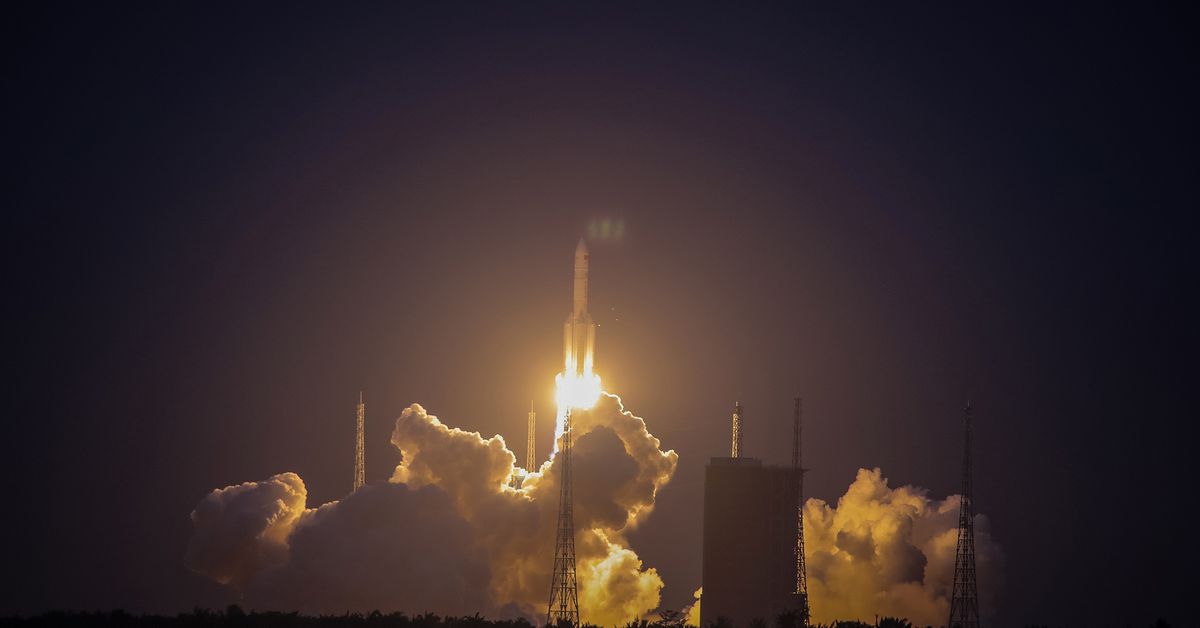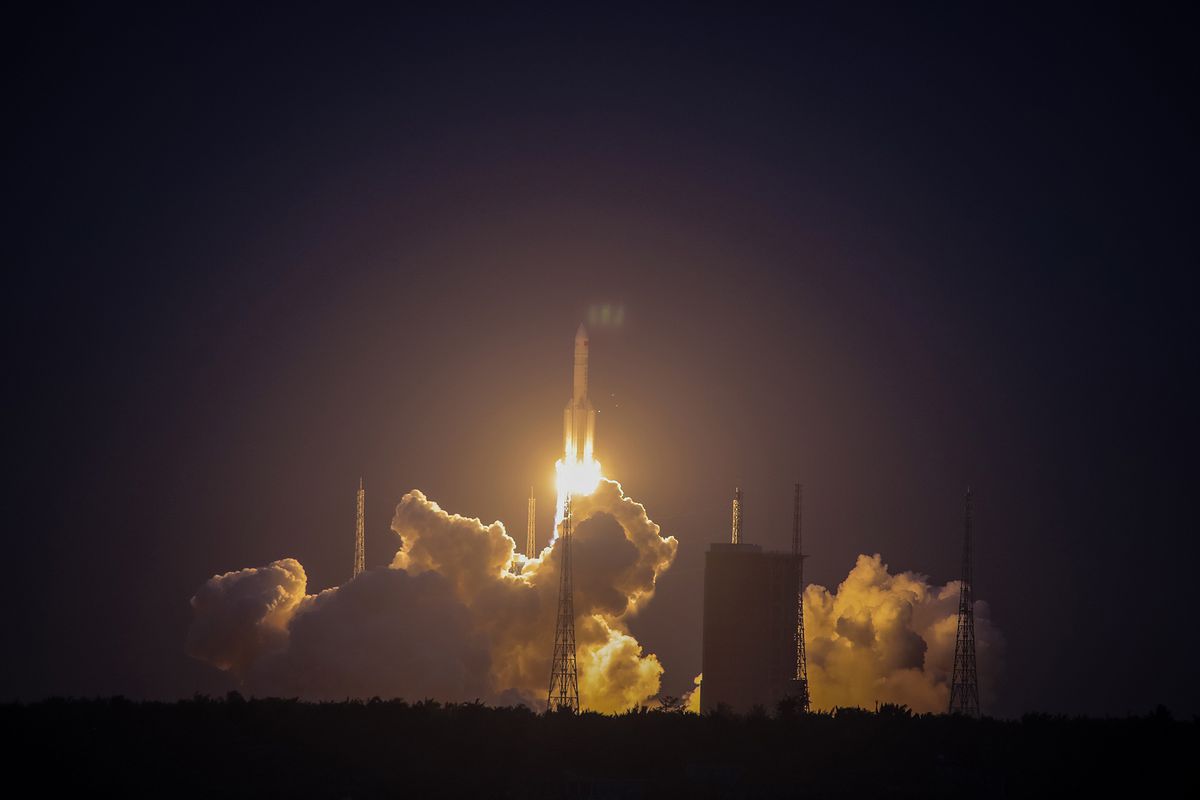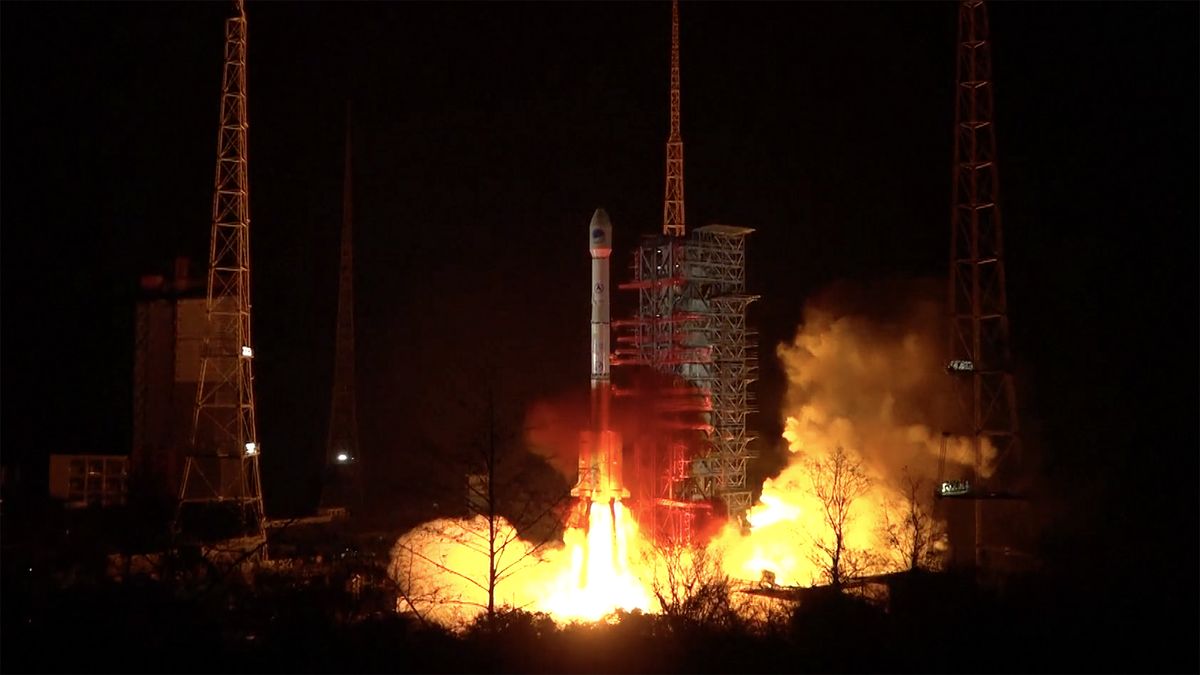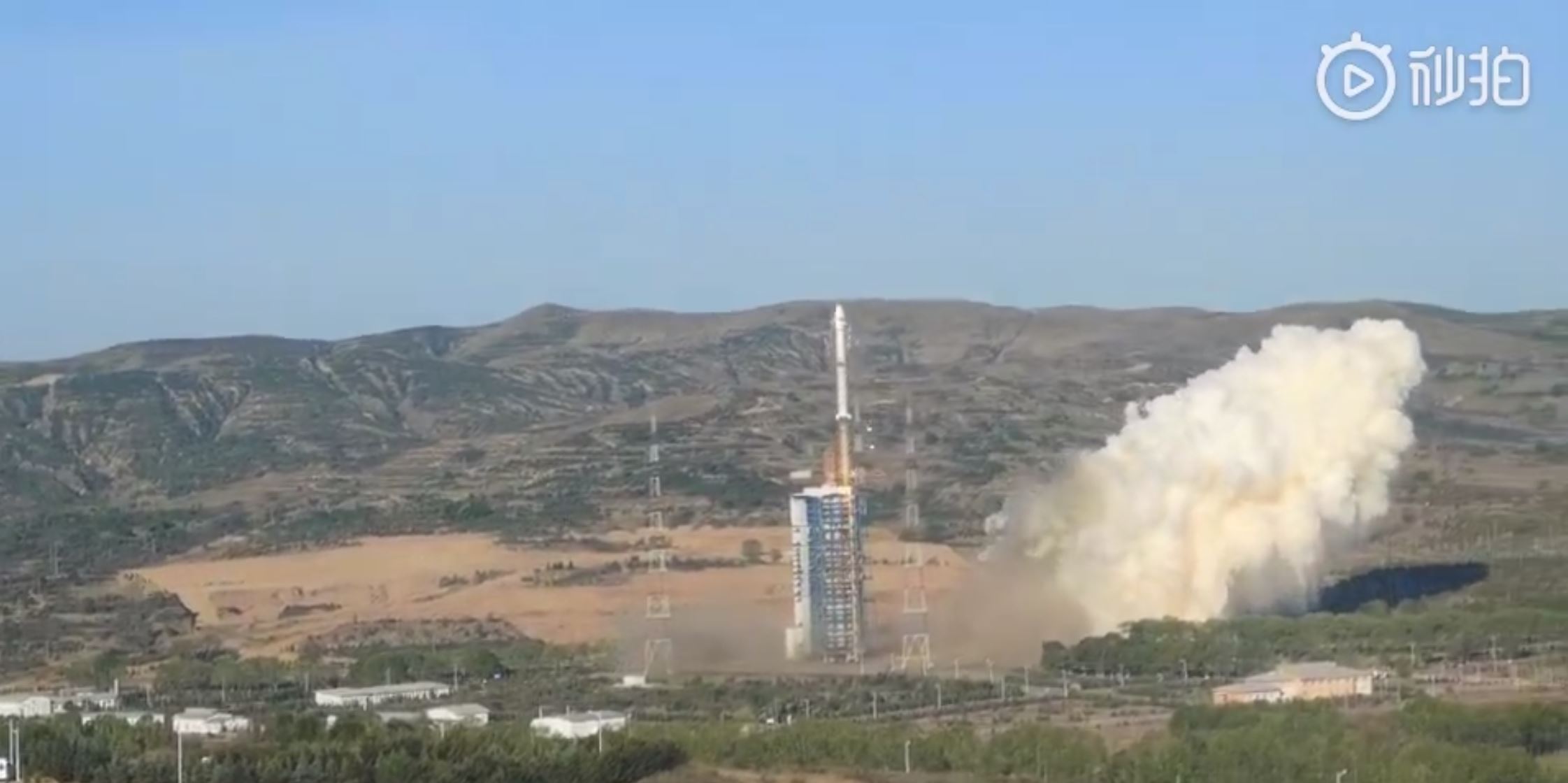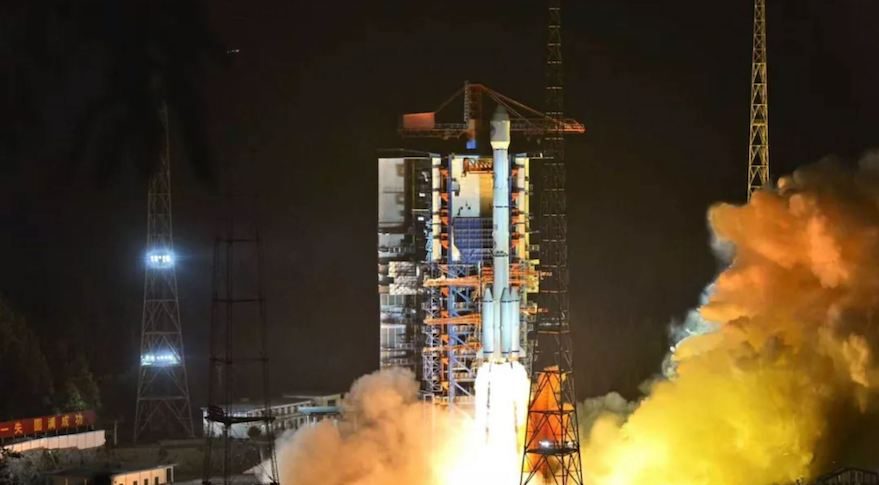HariPrasad-1
Senior Member
- Joined
- Jan 7, 2016
- Messages
- 9,621
- Likes
- 21,090
Out-of-control’ Chinese rocket falling to Earth could partially survive re-entry
Long March 5B is doing 27,600km/h in failing orbit, with eventual crash site unknown, after launching space station hub

The Long March5B Chinese rocket launched a module of the country’s space station on 29 April. The rocket’s core is falling out of Earth’s orbit and is expected to make an uncontrolled re-entry this week.
Photograph: VCG/Getty Images
Alison Rourke
Tue 4 May 2021 03.55 BST
4,272
Part of a huge rocket that launched China’s first module for its Tianhe space station is falling back to Earth and could make an uncontrolled re-entry at an unknown landing point.
The 30-metre high core of the Long March 5B rocket launched the “Heavenly Harmony” unmanned core module into low Earth orbit on 29 April from Wenchang in China’s Hainan province.
The Long March 5B then itself entered a temporary orbit, setting the stage for one of the largest ever uncontrolled re-entries. Some experts fear it could land on an inhabited area.
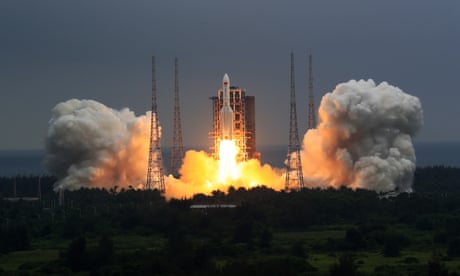
China launches first module of new space station
Read more
“It’s potentially not good,” said Jonathan McDowell, Astrophysicist at the Astrophysics Center at Harvard University.
“Last time they launched a Long March 5B rocket they ended up with big long rods of metal flying through the sky and damaging several buildings in the Ivory Coast,” he said.
“Most of it burned up, but there were these enormous pieces of metal that hit the ground. We are very lucky no one was hurt.”
On Tuesday the core was orbiting Earth around every 90 minutes at about 27,600km/h and an altitude of more than 300km. The US military has named it 2021-035B and its path can be seen on websites including orbit.ing-now.com.
01:13
Heavenly Harmony: China launches first module of new space station – video
Since the weekend it has dropped nearly 80km in altitude and SpaceNews reported that amateur ground observations showed it was tumbling and not under control. This, and its speed, makes it impossible to predict where it will land when Earth’s atmosphere eventually drags it down, though McDowell said the most likely outcome is that it will fall into the sea, as the ocean covers about 71% of the planet.
Advertisement
But McDowell says some pieces of the rocket will survive re-entry and that it would be the “equivalent of a small plane crash scattered over 100 miles”.
Since 1990 nothing over 10 tonnes has been deliberately left in orbit to re-enter uncontrolled. The Long March 5B core stage is thought to be about 21 tonnes.
“What’s bad is that it’s really negligent on China’s part. Things more than ten tonnes we don’t let them fall out of the sky uncontrolled deliberately,” McDowell said.
Based on its current orbit the rocket is passing over Earth as far north as New York, Madrid and Beijing and as far south as southern Chile and Wellington, New Zealand, and could make its re-entry at any point within this area.
Given its velocity, a small change in its path could make a big difference to where it ends up. It’s expected to return to Earth on 10 May, plus or minus two days.
McDowell said once it’s clear the day it is returning to Earth, experts could predict its landing time within a six-hour window.
The rocket’s launch was part of 11 planned missions as part of the construction of China’s space station, which is expected to be completed in late 2022. The T-shaped space station is expected to weigh about 60 tonnes, considerably smaller than the International Space Station, which launched its first module in 1998 and weighs about 408 tonnes.
China’s space station will have a docking port and will also be able to connect with a Chinese satellite. Theoretically it could be expanded to as many as six modules.

 www.theguardian.com
www.theguardian.com
Long March 5B is doing 27,600km/h in failing orbit, with eventual crash site unknown, after launching space station hub
- LATEST: Falling Chinese rocket to crash to Earth on Saturday as US calls for ‘responsible space behaviours’

The Long March5B Chinese rocket launched a module of the country’s space station on 29 April. The rocket’s core is falling out of Earth’s orbit and is expected to make an uncontrolled re-entry this week.
Photograph: VCG/Getty Images
Alison Rourke
Tue 4 May 2021 03.55 BST
4,272
Part of a huge rocket that launched China’s first module for its Tianhe space station is falling back to Earth and could make an uncontrolled re-entry at an unknown landing point.
The 30-metre high core of the Long March 5B rocket launched the “Heavenly Harmony” unmanned core module into low Earth orbit on 29 April from Wenchang in China’s Hainan province.
The Long March 5B then itself entered a temporary orbit, setting the stage for one of the largest ever uncontrolled re-entries. Some experts fear it could land on an inhabited area.

China launches first module of new space station
Read more
“It’s potentially not good,” said Jonathan McDowell, Astrophysicist at the Astrophysics Center at Harvard University.
“Last time they launched a Long March 5B rocket they ended up with big long rods of metal flying through the sky and damaging several buildings in the Ivory Coast,” he said.
“Most of it burned up, but there were these enormous pieces of metal that hit the ground. We are very lucky no one was hurt.”
On Tuesday the core was orbiting Earth around every 90 minutes at about 27,600km/h and an altitude of more than 300km. The US military has named it 2021-035B and its path can be seen on websites including orbit.ing-now.com.
01:13
Heavenly Harmony: China launches first module of new space station – video
Since the weekend it has dropped nearly 80km in altitude and SpaceNews reported that amateur ground observations showed it was tumbling and not under control. This, and its speed, makes it impossible to predict where it will land when Earth’s atmosphere eventually drags it down, though McDowell said the most likely outcome is that it will fall into the sea, as the ocean covers about 71% of the planet.
Advertisement
But McDowell says some pieces of the rocket will survive re-entry and that it would be the “equivalent of a small plane crash scattered over 100 miles”.
Since 1990 nothing over 10 tonnes has been deliberately left in orbit to re-enter uncontrolled. The Long March 5B core stage is thought to be about 21 tonnes.
“What’s bad is that it’s really negligent on China’s part. Things more than ten tonnes we don’t let them fall out of the sky uncontrolled deliberately,” McDowell said.
Based on its current orbit the rocket is passing over Earth as far north as New York, Madrid and Beijing and as far south as southern Chile and Wellington, New Zealand, and could make its re-entry at any point within this area.
Given its velocity, a small change in its path could make a big difference to where it ends up. It’s expected to return to Earth on 10 May, plus or minus two days.
McDowell said once it’s clear the day it is returning to Earth, experts could predict its landing time within a six-hour window.
The rocket’s launch was part of 11 planned missions as part of the construction of China’s space station, which is expected to be completed in late 2022. The T-shaped space station is expected to weigh about 60 tonnes, considerably smaller than the International Space Station, which launched its first module in 1998 and weighs about 408 tonnes.
China’s space station will have a docking port and will also be able to connect with a Chinese satellite. Theoretically it could be expanded to as many as six modules.

‘Out-of-control’ Chinese rocket falling to Earth could partially survive re-entry
Long March 5B is doing 27,600km/h in failing orbit, with eventual crash site unknown, after launching space station hub

